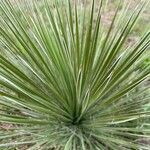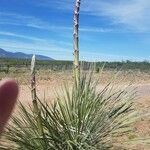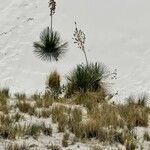Plants solitary or forming small colonies of rosettes, caulescent or rarely acaulescent, distinctly arborescent, mostly few-branched, 1.2–4.5 m; rosettes usually large, symmetrical or asymmetrical. Stems 1–7 per colony, erect, thick, 1–1.5(–2.5) m. Leaf blade pale green, linear, widest near middle, 25–95 × 0.2–1.3 cm, flexible, margins entire, curled, filiferous, whitish, apex tapering to short spine. Inflorescences mostly paniculate, sometimes distally racemose, arising beyond rosettes, mostly narrowly ovoid to ovoid, 7–15 × 2.5–6.5 dm; branches 0.7–3.5 dm; bracts erect; peduncle sometimes scapelike, 1–2 m, 2.5–5.5 cm diam. Flowers pendent; perianth campanulate or globose; tepals distinct, creamy white, often tinged green or pink, narrow to broadly elliptic or ovate, 3.2–5.7 × 1.3–3.2 cm; filaments 1.5–2.5(–3.2) cm, pubescent; anthers (2–)2.5–4.8 mm; pistil 2–3.2 × 0.6–1 cm; style white or pale green, 6–11 mm; stigmas lobed. Fruits erect, capsular, dehiscent, oblong-cylindric, symmetrical or rarely constricted, 4–8.2 × 2–4 cm, dehiscence septicidal. Seeds dull black, thin, 7–11(–14) mm diam.
More
A shrub. It grows 3 m high and spreads 1.5 m wide. It develops suckers. There are several stems covered with old dead leaves. The new leaves are light green. There are fine hairs along the edge. The flower stalk is 1.8 m high. The flowers are creamy white with pink and green tints.
Mesas, desert washes, plains and desert grasslands, and in deserts, preferring deep, compact, sandy soils; normally at elevations from 500-2,000 metres.
More
It is a subtropical to tropical plant. It suits hardiness zones 9-11.
Can be grown by cuttings, divisions or seedlings. Seeds needs soaking.




